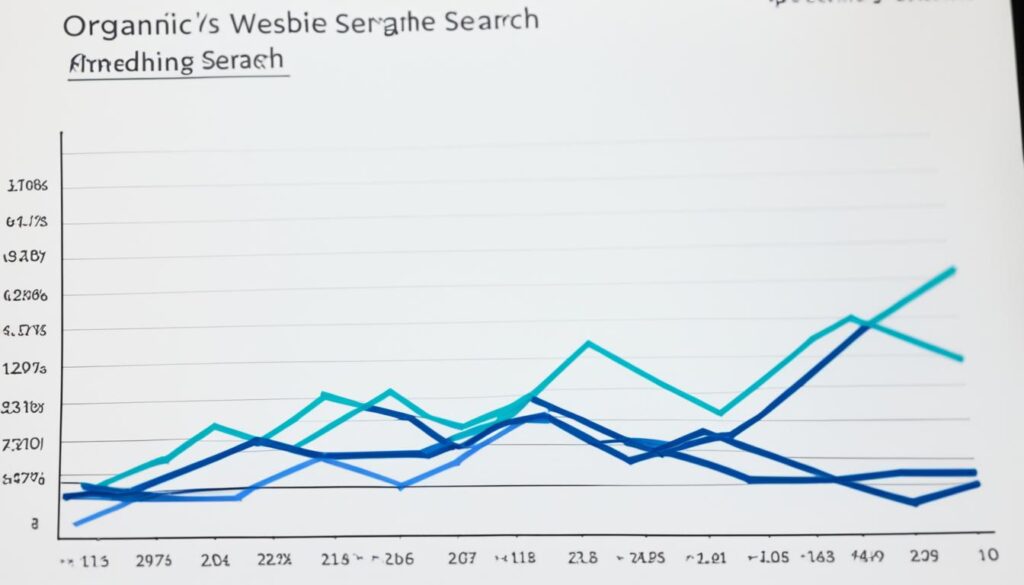
When it comes to redesigning your website, it's crucial to consider the impact it can have on your search rankings. Website redesign SEO plays a vital role in maintaining your organic visibility and ensuring that your site continues to rank highly on search engine results pages (SERPs).
In this article, I will explore the key strategies and best practices for preserving your rankings during a website redesign. By implementing effective SEO techniques, you can safeguard your search rankings and maintain your site's visibility.
Key Takeaways:
- Website redesign can impact your search rankings.
- Implementing SEO strategies during the redesign process is crucial.
- Thorough keyword research and optimizing on-page elements are key.
- Proper URL structure, responsive design, and fast site speed are important for SEO.
- Monitoring and measuring post-redesign SEO performance is essential.
Understanding the Importance of SEO in Website Redesign
When it comes to website redesign, implementing effective SEO strategies is crucial in preserving your search rankings. Website redesigns often involve significant changes to the structure, design, and content of your site. Such changes can impact how search engines interpret and rank your website.
By prioritizing SEO during the redesign process, you can ensure that your site remains optimized for search engines and maintains its ranking positions. This is essential for preserving the organic visibility you've worked hard to achieve.
During a website redesign, you have the opportunity to align your site with current SEO best practices, optimize for relevant keywords, improve user experience, and boost overall search performance. Ignoring SEO during a website redesign can result in a significant loss of organic traffic and rankings.
One of the key considerations in preserving your search rankings during a website redesign is maintaining the integrity of your SEO efforts. This includes keeping important keywords, optimizing on-page elements such as title tags and meta descriptions, and ensuring proper URL structure and redirects.
Additionally, a strong focus on mobile optimization and site speed is crucial, as these factors have a significant impact on search rankings. By creating a responsive design and optimizing your website's loading time, you can enhance user experience and improve your search performance.
Another important aspect to consider in preserving your search rankings during a website redesign is an effective content migration plan. This involves mapping out how your existing content will be transferred to the new site, ensuring that all pages are properly redirected and that valuable content is preserved.
Ultimately, prioritizing SEO during a website redesign is essential for maintaining and improving your search rankings. By understanding the importance of SEO in this process, you can make informed decisions to ensure that your website redesign is a success.
SEO Best Practices for Website Redesign
Implementing SEO best practices during a website redesign is crucial for preserving your search rankings. To ensure the success of your redesign and maintain or even improve your search rankings, it is important to focus on the following key considerations and strategies:
Thorough Keyword Research
Conducting comprehensive keyword research is essential before implementing any changes to your website. By identifying relevant and high-performing keywords, you can optimize your content, meta tags, and other on-page elements to enhance your search visibility and maintain your rankings.
Optimizing On-Page Elements
During the redesign process, pay close attention to your on-page elements, including title tags, meta descriptions, headings, and image alt tags. Ensure that they are optimized with relevant keywords and accurately reflect the content of your pages. This will help search engines understand your content and improve your search rankings.
Proper URL Structure and Redirects
When redesigning your website, it is important to maintain a consistent URL structure or implement redirects properly. This ensures that search engines can still index and rank your pages correctly. Broken or outdated URLs can result in lost rankings and negatively impact user experience.
Implementing a Responsive Design
In today's mobile-centric world, having a responsive design is crucial for both user experience and search rankings. A responsive website adapts to different screen sizes and devices, ensuring that users can easily navigate and engage with your content. This is especially important as mobile-first indexing becomes the norm for search engines.
Optimizing Site Speed
Site speed is a critical factor when it comes to user experience and SEO. Slow-loading websites not only frustrate users but also receive lower search rankings. Optimize your website's performance by minimizing file sizes, leveraging caching techniques, and optimizing server response times.
Creating a Comprehensive Content Migration Plan
During a website redesign, it's essential to plan and execute a smooth content migration to avoid losing valuable SEO rankings. Prioritize mapping your existing content to relevant new pages, maintaining internal links, and implementing appropriate redirects. By ensuring that your content remains accessible and organized, you can preserve your search rankings and avoid broken links.
Implementing these SEO best practices during your website redesign will help minimize any negative impact on your search rankings and ensure that your site continues to perform well in search engine results pages.

| SEO Best Practices for Website Redesign | Benefits |
|---|---|
| Thorough Keyword Research | – Improved search visibility – Relevance to user queries |
| Optimizing On-Page Elements | – Better understanding by search engines – Higher click-through rates |
| Proper URL Structure and Redirects | – Maintained indexation – Seamless user experience |
| Implementing a Responsive Design | – Enhanced user experience – Improved mobile rankings |
| Optimizing Site Speed | – Increased user satisfaction – Higher search rankings |
| Creating a Comprehensive Content Migration Plan | – Preserved SEO value – Seamless content transition |
Monitoring and Measuring SEO Performance Post Redesign
Once your website redesign is complete, it's essential to monitor and measure the performance of your SEO efforts. This will help you identify any potential issues or areas for improvement and ensure that your search rankings are preserved. In this final section, I will discuss the key metrics and tools you can use to track your SEO performance post-redesign.
Maintaining SEO Performance with Post-Redesign Monitoring
After investing time and resources into a website redesign, it's important to ensure that your search rankings remain intact. By monitoring your SEO performance post-redesign, you can spot any unforeseen consequences and take necessary actions to preserve your rankings. Here are some essential metrics and tools to consider:
- Organic traffic and rankings: Regularly monitor your website's organic traffic and rankings to gauge the impact of the redesign. Keep an eye on any significant changes and investigate any unexpected drops or spikes in traffic.
- Site audits: Conducting routine site audits allows you to identify technical issues that may hinder your SEO performance. Check for broken links, duplicate content, or any other factors that could negatively impact your search rankings.
- User engagement metrics: Analyze user engagement metrics such as bounce rate, time on page, and conversion rates to assess the effectiveness of your redesigned site. Identify pages or elements that need improvement to enhance user experience and encourage higher engagement.
- Google Analytics: Leverage the power of Google Analytics to gain valuable insights into your post-redesign SEO performance. Track key metrics, analyze user behavior, and measure the success of your SEO efforts based on conversion and goal tracking.
- Google Search Console: Utilize Google Search Console to monitor your organic search presence, submit sitemaps, and identify any indexing or crawling issues that may arise post-redesign. Stay proactive in resolving any detected issues promptly.
Take Control of Your SEO Performance Post Redesign
By actively monitoring and measuring your SEO performance post-redesign, you can make data-driven decisions and implement necessary optimizations to maintain and improve your search rankings. Stay vigilant, keep a close eye on the metrics that matter, and take control of your website's SEO success.
| Metric | Tool/Method |
|---|---|
| Organic traffic and rankings | Regularly track using Google Analytics and SEO monitoring tools |
| Site audits | Perform routine audits using tools like Screaming Frog or Sitebulb |
| User engagement metrics | Monitor using Google Analytics and heatmapping tools |
| Google Analytics | Utilize the full suite of Google Analytics for in-depth analysis |
| Google Search Console | Regularly check for indexing issues and submit sitemaps |

With post-redesign monitoring and effective SEO performance measurement, you can stay ahead of any potential challenges, preserve your search rankings, and ensure the success of your website's redesign.
Conclusion
In conclusion, when undergoing a website redesign, it is crucial to prioritize website redesign SEO to preserve your search rankings and maintain organic visibility. By implementing effective SEO strategies and best practices throughout the redesign process, you can ensure that your site remains optimized for search engines and continues to rank highly on search engine results pages (SERPs).
Furthermore, monitoring and measuring the performance of your SEO efforts post-redesign is equally important. By actively tracking organic traffic, rankings, user engagement metrics, and conducting regular site audits, you can identify any potential issues and make necessary improvements to safeguard your search rankings.
With the right approach and attention to detail, you can successfully navigate the website redesign process while protecting your search rankings. Remember, website redesigns should not be treated as standalone projects, but rather as opportunities to enhance your site's overall SEO performance and user experience. By incorporating SEO considerations from the outset and throughout the redesign, you can ensure that your website remains competitive and continues to attract valuable organic traffic.
FAQ
Why is SEO important during a website redesign?
SEO is important during a website redesign because significant changes to the structure, design, and content of your site can directly impact your search rankings. By implementing effective SEO strategies, you can ensure that your site remains optimized for search engines and maintains its ranking positions.
What are the key SEO considerations during a website redesign?
The key SEO considerations during a website redesign include conducting thorough keyword research, optimizing on-page elements such as title tags and meta descriptions, ensuring proper URL structure and redirects, implementing a responsive design, optimizing site speed, and creating a comprehensive content migration plan.
How can I measure the performance of my SEO efforts post-redesign?
To measure the performance of your SEO efforts post-redesign, you can monitor organic traffic and rankings, conduct regular site audits, analyze user engagement metrics, and leverage tools such as Google Analytics and Google Search Console.
Why is it important to monitor the performance of SEO efforts post-redesign?
Monitoring the performance of SEO efforts post-redesign is important to identify any potential issues or areas for improvement. It helps ensure that your search rankings are preserved and provides insights to make informed decisions and take necessary actions for maintaining and improving your search rankings.
How can I preserve my search rankings during a website redesign?
You can preserve your search rankings during a website redesign by implementing effective SEO strategies and best practices. This includes conducting thorough keyword research, optimizing on-page elements, ensuring proper URL structure and redirects, implementing a responsive design, optimizing site speed, and creating a comprehensive content migration plan.











